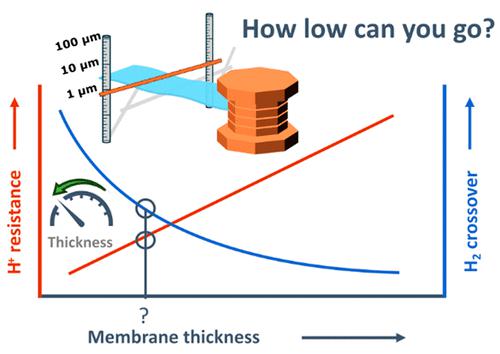当前位置:
X-MOL 学术
›
ACS Energy Lett.
›
论文详情
Our official English website, www.x-mol.net, welcomes your feedback! (Note: you will need to create a separate account there.)
How Low Can You Go? Nanoscale Membranes for Efficient Water Electrolysis
ACS Energy Letters ( IF 22.0 ) Pub Date : 2024-03-20 , DOI: 10.1021/acsenergylett.4c00170 Lucas A. Cohen 1 , Matthew S. Weimer 2 , Kyungmin Yim 1 , Jingjing Jin 1 , Daniela V. Fraga Alvarez 1 , Arrelaine A. Dameron 2 , Christopher B. Capuano 3 , Ryan J. Ouimet 3 , Serafina Fortiner 3 , Daniel V. Esposito 1
ACS Energy Letters ( IF 22.0 ) Pub Date : 2024-03-20 , DOI: 10.1021/acsenergylett.4c00170 Lucas A. Cohen 1 , Matthew S. Weimer 2 , Kyungmin Yim 1 , Jingjing Jin 1 , Daniela V. Fraga Alvarez 1 , Arrelaine A. Dameron 2 , Christopher B. Capuano 3 , Ryan J. Ouimet 3 , Serafina Fortiner 3 , Daniel V. Esposito 1
Affiliation

|
Motivated by the need to lower the cost of hydrogen (H2) production by water electrolysis, significant research efforts are focused on making proton (H+) exchange membrane (PEM) water electrolyzers more efficient and capable of operating at higher current densities. These aims can be met by making H+-conducting membranes thinner, which has the effect of lowering ohmic drops across the membrane that represent the largest efficiency loss at high current densities (>2 A cm–2). However, decreasing membrane thickness below 50 μm is not trivial due to trade-offs between membrane resistance, H2 crossover (safety), membrane degradation, and manufacturing throughput. Herein, descriptions of key processes, limitations, and trade-offs that arise in thin membranes are provided that can be used to guide the design of ultrathin (i.e., submicron thick), low-resistance membrane materials that have the potential to transform the field of clean H2 production.
中文翻译:

你能降到多低?用于高效水电解的纳米级膜
由于需要降低水电解制氢 (H 2 ) 的成本,大量研究工作集中在使质子 (H + ) 交换膜 (PEM) 水电解槽更加高效并能够在更高的电流密度下运行。这些目标可以通过使 H +传导膜更薄来实现,这具有降低膜上欧姆压降的效果,欧姆压降代表高电流密度 (>2 A cm –2 ) 下的最大效率损失。然而,由于膜电阻、H 2交叉(安全性)、膜降解和制造产量之间的权衡,将膜厚度减小到 50 μm 以下并非微不足道。本文提供了薄膜中出现的关键工艺、限制和权衡的描述,可用于指导超薄(即亚微米厚)、低电阻膜材料的设计,这些材料有可能改变该领域清洁H 2生产。
更新日期:2024-03-20
中文翻译:

你能降到多低?用于高效水电解的纳米级膜
由于需要降低水电解制氢 (H 2 ) 的成本,大量研究工作集中在使质子 (H + ) 交换膜 (PEM) 水电解槽更加高效并能够在更高的电流密度下运行。这些目标可以通过使 H +传导膜更薄来实现,这具有降低膜上欧姆压降的效果,欧姆压降代表高电流密度 (>2 A cm –2 ) 下的最大效率损失。然而,由于膜电阻、H 2交叉(安全性)、膜降解和制造产量之间的权衡,将膜厚度减小到 50 μm 以下并非微不足道。本文提供了薄膜中出现的关键工艺、限制和权衡的描述,可用于指导超薄(即亚微米厚)、低电阻膜材料的设计,这些材料有可能改变该领域清洁H 2生产。



























 京公网安备 11010802027423号
京公网安备 11010802027423号